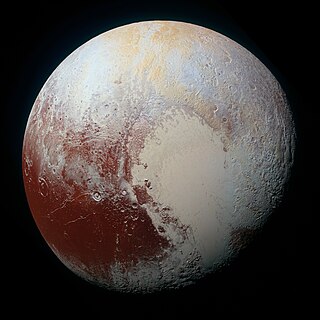
Planetary nomenclature, like terrestrial nomenclature, is a system of uniquely identifying features on the surface of a planet or natural satellite so that the features can be easily located, described, and discussed. Since the invention of the telescope, astronomers have given names to the surface features they have discerned, especially on the Moon and Mars. To found an authority on planetary nomenclature, the International Astronomical Union (IAU) was organized in 1919 to designate and standardize names for features on Solar System bodies.

Buys-Ballot is an oddly-shaped lunar impact crater that is located on the far side of the Moon. The crater was named by the IAU in 1970.
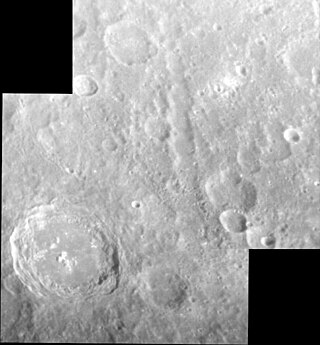
Haystack Catena is a catena on Mercury. It superficially resembles a graben but is a chain of overlapping secondary craters. It is named after Haystack Observatory, and was originally named Haystack Vallis when it was imaged by Mariner 10 in 1974, but the name was changed in 2013 to better reflect its origin. It is approximately 274 km long. It is located near the center of the Kuiper quadrangle, and it is radial to a large, unnamed crater that is Tolstojan in age.

Raphael is a crater on Mercury. Its name was adopted by the International Astronomical Union (IAU) in 1976, and is named for the Italian painter Raphael. It is Tolstojan in age.

Bashō is a crater on Mercury named after Matsuo Bashō, a 17th-century Japanese writer. Bashō crater is only 74.62 kilometers (46.37 mi) in diameter, but is a prominent feature on Mercury's surface, due to its bright rays. Photographs from NASA's Mariner 10 and MESSENGER spacecraft show a curious halo of dark material around the crater. The dark material is typically referred to as low-reflectance material (LRM) and there is evidence that it is caused by graphite.

Verdi is an impact crater on the planet Mercury. It was named after Italian Romantic composer Giuseppe Verdi (1813–1901) in 1979, as recognized by the International Astronomical Union. The crater's extensive ejecta blanket and secondary crater field are superposed on plains materials and older craters.
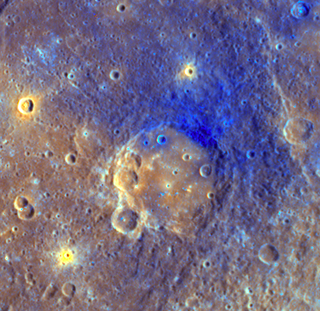
Titian is an impact crater on the planet Mercury. It was named by the IAU in 1976.

Calvino is a crater on Mercury. Its name was adopted by the IAU in 2016, after the Italian writer Italo Calvino.

Hemingway is a crater on Mercury. It has a patch of very dark material located near its center. The dark color is likely due to rocks that have a different mineralogical composition from that of the surrounding surface.

Matabei is an impact crater on Mercury. It has a set of dark rays. Dark rays are rare on Mercury, but other occurrences have been identified, such as at Mozart crater. Mozart crater is interpreted to have excavated dark material from depth during the impact event, creating dark streamers. The dark rays from Matabei may have a similar origin.

Donne is a crater on Mercury. It has a diameter of 86 kilometers. Its name was adopted by the International Astronomical Union (IAU) in 1976. Donne is named for the English poet John Donne, who lived from 1572 to 1631.
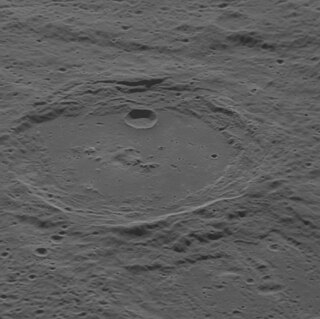
Hauptmann is a crater on Mercury. It has a diameter of 118 kilometers. Its name was adopted by the International Astronomical Union (IAU) in 1985. Hauptmann is named for the German playwright Gerhart Hauptmann, who lived from 1862 to 1946.

Judah Ha-Levi is a crater on Mercury. Its name was adopted by the International Astronomical Union (IAU) in 1976. Judah Ha-Levi is named for the Spanish-Jewish poet and philosopher Judah Ha-Levi, who lived from 1075 to 1141.
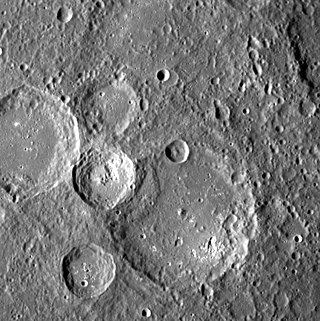
Mistral is a crater on Mercury. Its name was adopted by the International Astronomical Union (IAU) in 1976. Mistral is named for the Chilean poet Gabriela Mistral, who lived from 1889 to 1957.

Mussorgskij is a crater on Mercury. Its name was adopted by the International Astronomical Union (IAU) in 1979. Mussorgskij is named for the Russian composer Modest Mussorgsky, who lived from 1839 to 1881. The crater was first imaged by Mariner 10 in 1974.

Enheduanna is a crater on Mercury. It has a diameter of 105 kilometers. Its name was suggested by Gagan Toor from India in a naming contest which was eventually adopted by the International Astronomical Union (IAU) on 2015. Enheduanna is named for the Sumerian poet Enheduanna. The craters Carolan, Kulthum, Karsh, and Rivera were also named as part of the contest.
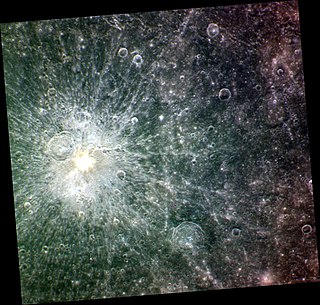
Nureyev is a crater on Mercury. It has a diameter of 16 kilometers, and has a bright and extensive ray system. Its name was adopted by the International Astronomical Union (IAU) on April 24, 2012. Nureyev is named for the Soviet and British ballet dancer Rudolf Nureyev.

Villa-Lobos is a crater on Mercury. Its name was adopted by the International Astronomical Union (IAU) on September 25, 2015. Villa-Lobos is named for the Brazilian composer Heitor Villa-Lobos.

Anguissola is a crater on Mercury. It has a diameter of 35.41 kilometres. Its name was adopted by the International Astronomical Union (IAU) on August 4, 2017. Anguissola is named for the Italian painter Sofonisba Anguissola.

Flaiano is a crater on Mercury. It has a diameter of 43 kilometres. Its name was adopted by the International Astronomical Union (IAU) on March 15, 2013. Flaiano is named for the Italian writer Ennio Flaiano.






















